
| CONTENT - Most basic knowledge to get should you plan to settle somewhere in the solar system! |
The solar system might one day be by colonized by humans, either the planets themselves, or some of their moons, under the form of settlements on the surface or of large orbital stations. The conditions concerning the human life there however are mostly -and always- unfavourable to the terrestrial life. This tutorial is providing you with a traveler's guide, should you participate into one of those settlers's missions. Just check what the conditions are where you're aiming to leave to!
note: the views of the surface of the planets -the right side pictures on the following illustrations- are supposed to have the observer located to the mid-northern latitudes, as he is supposed to be facing West (in the case of the planets having a retrograde rotation, the observer is supposed to be facing East)
any picture on the top, right side of the illustrations of this tutorial, made with Celestia; pictures left are originating from varied sources; all pictures copyright site 'Amateur Astronomy'
| From Mercury to Mars The Gas Giants | Pluto |
| Mercury Venus | The Earth and the Moon Mars |
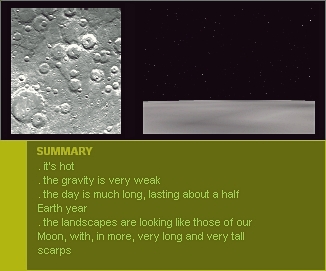
As you should weigh about 154 lbs (70 kg) on the Earth, you are just weighing 59 lbs (27 kg) only now, on Mercury. We are just 36 million miles (58 million kilometers) from the Sun only. The year, on Mercury, is lasting 88 Earth days (nearly 3 Earth months that is) as the day is lasting 176 Earth days. Due to that the axial tilt (the tilt of the poles' axis) of Mercury is null leads to that there are no seasons at Mercury. A form of important orbital eccentricity however -the most important in the solar system, Pluto excepted- with a difference of 15 million miles (24 million kilometers) between the perihelion (the nearest Sun on the orbit) and the aphelion (the farthest Sun) may bring a form of modulation of the surface conditions
The mean surface temperature is 333° F (167° C) because we are close to the Sun. The Sun, in the sky of Mercury, has an apparent diameter of 1 degree and 27 arcminutes! Mercury is benefiting from a very weak magnetosphere only
Mercury has no moons. Hence there are no moons in the night sky of the planet. As seen from Mercury, no any planets is seen like a morning -or evening- star because no planet in the solar system is lying between Mercury and the Sun. As seen from Mercury, all the planets of the solar system are thus seen like moving, year long, along the zodiac. Due to Mercury having no atmosphere, the sky, there, is always dark -like on our Moon- and the variation of temperature between a location exposed to the Sun, and a one out of it, is always extremely sharp, with an immediate change of temperature!
Mercury landscapes are mostly craters, very long and very tall scarps and, with, here and there, large basins looking like the lunar 'mare'. The ground is made of regolith, which a product of the disintegration of it by the bombardment of the surface my micro-meteorids. There maybe is water at the poles of Mercury. The relatively small diameter of Mercury is bringing to a feeling of a greater closeness of the horizon
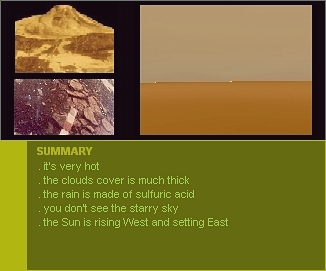
As you should weigh about 154 lbs (70 kg) on the Earth, you are weighing about the same weight on Venus, at 140 lbs (63 kg). We are there at 67,200,000 miles (108,200,000 km) from the Sun. The year, on Venus, is lasting 224 Earth days (or about 7 Earth months and a half). The Venusian day is lasting 117 Earth days. Venus has that pecularity of having its poles' axis tilted by 177 degree compared to the plane of its orbit. This tilt of near 180 degree means that the axis of Venus is really about reversed, bringing to that the rotation of Venus is (in fact look like it is) reversed, with the planet rotating about itself clockwise, at the opposite of the other planets in the solar system that is. The Sun, at Venus, is seen rising West, and setting East! The axial tilt of Venus is such that it's eventually having a value of 2.6 degree tilt only to the orbit's plane. This makes that there is about no seasons at Venus as the near-circularity of the orbit, on the other hand, don't bring any either
The mean surface temperature is 867° F (464° C). This is very hot! Such a temperature is not due mostly to the fact that we are close to the Sun than it to be linked to an important greenhouse effect. The greenhouse effect at Venus is due to the thickness of the clouds layers in the atmosphere. The greenhouse effect of the origins at Venus endured a runaway evolution, with the Sun's radiation trapped by the clouds cover in a cumulative way and yielding a pressure 90 times larger than at Earth. At the difference of the Earth where the atmosphere regulated itself to a beneficial greenhouse effect, or of Mars, where the atmosphere mostly disappeared, the atmosphere at Venus became thick. The surface of Venus is not protected by any magnetic field at the exception of a 'atmospheric magnetosphere', where the ionosphere of the planet -the externalmost layer of the atmosphere- is playing that role of protection against the solar wind
Venus does not have any moons. As seen from Venus, Mercury only is seen like a morning -or an evening- star, with all the other planets of the solar system seen moving along the zodiac. The very thick atmosphere of Venus -with the clouds 18.5 to 24.8 miles (30-40 km) thick- is forbidding any view of the sky, the night sky included. Thus, no starry sky at Venus!
The landscapes at Venus are plains and volcanoes, with mountain ranges and craters. The rain however is made of sulfuric acid and the atmospheric pressure, at the surface of Venus, is enormous due to the gigantic clouds cover
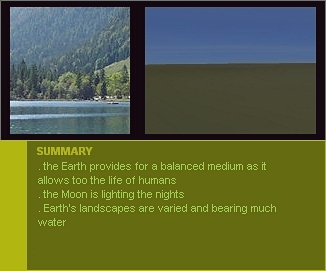
Here, we are on the Earth, the 'blue planet', our own planet! Your weighing 154 lbs (70 kg). We are at 98 million miles (150 millions kilometers) from the Sun. The year, at Earth, is lasting 365 days -which is the time the Earth is taking to perform its orbit around the Sun- as the day is lasting 24 hours -the time the Earth takes to rotate about itself, from the West to the East. The axial tilt at the Earth is relatively important, generating the phenomenon of the seasons
The mean surface temperature is 59° F (15° C). This favourable temperature is due to a relatively important distance from the Sun and to the interaction processes induced through the Earth's atmosphere and oceans. The Earth's atmosphere, among others, is generating a natural greenhouse effect which allows to rise the temperatures by about 60° F (30° C)! The atmosphere of the Earth is the only one, in the solar ssytem, to allow the humans to breathe freely. The humans, at the surface of the Earth, are protected from the radiation of the interplanetary space through the 'magnetosphere', which is a magnetic envelope generated by the magnetic field of the Earth
The Earth is featuring one moon, the Moon, proper. The Moon is lighting our nights. From the Earth, Venus and Mercury are seen like morning -or evening- stars as all the other planets in the solar system are seen like moving, year long, along the zodiac. The atmosphere of the Earth is light enough to allow the alternance of the days and nights, and the sight of the starry sky at night
The landscapes, on the Earth, are alternating, and varied with the vegetation cover often extent -which is more or less dense- and water (under the form of large rivers, rivers, and lakes) is another constant. Vast oceans, along with vast deserts too, are existing too on the Earth
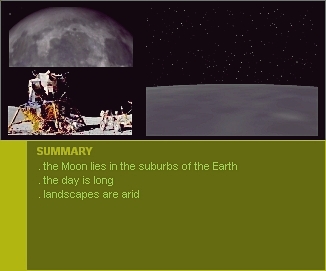
Our Moon, which is the Earth's moon, is the celestial body which is the nearest to us. The Moon, in average, is lying at 239,000 miles (384,400 km) from the Earth. The Moon has a size wich is relatively important compared to the one of Earth. Astronomers who would be observing us from any planet in the solar system, would see the Earth always neatly accompanied with the disk of the Moon. Should you weigh 154 lbs (70 kg) on the Earth, your weight on the Moon would be of 26 lbs (12 kg) only
Our Moon has a 'synchronous' rotation. This means that the Moon's rotational period equals its orbital period. In other terms, that means that the Moon is rotating about itself in the same time than it's revolving around Earth on its orbit. This duration is of about 27 Earth days. For a given point at the surface of the Moon, one day is thus lasting 27 Earth days as the Moon features a near, and a far side. Someone living on the near side will always get the Earth in his sky, whether it be day, or night. The 'full Earth' occurs when it's the new Moon for an Earthling, as it's the 'new Earth' on the Moon when it's the full Moon for us. A person located on the far side of the Moon, at the opposite, would never see the Earth. As there is no atmosphere at the Moon, the sky, as seen from the Moon, is always dark. The Moon has no magnetosphere
The landscapes at Moon are different according to whether one is located on the far, or the near side. On the far side, you'll mostly see ancient lands, filled with craters and mountain ranges. On the near side, at the contrary, you'll see that those ancient highlands and the craters are alternating with flat plains, which were created through lava flows, and which are called lunar 'mare'. The lunar soil is made of 'regolith', a fine dust which results from the disintegration of the ground due to the bombardment by the micro-meteorids. Water is maybe existing in the south pole of the Moon. Should any Terrestrians live on the Moon, they might, in some places, be visiting the remainings of ancient lunar missions, like the Surveyors or the takeoff stages of the Apollo lunar modules, etc.)
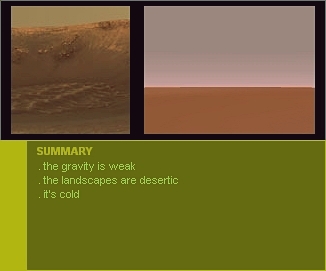
As you should weigh about 154 lbs (70 kg) on the Earth, you are just weighing 59 lbs (27 kg) only on Mars -like on Mercury! We are, at Mars, at 141,600,000 miles (227,900,000 km) from the Sun. The Martian year is lasting 687 Earth days -about close to two Earth years- as the Martian day is lasting 24.7 Earth day. The poles' axis of Mars, like the one of the Earth, has a relatively important tilt, at 25.2°. Like for the Earth, that is determining a phenomenon of seasons. The more important eccentricity of Mars, as far as its orbit is concerned, with the perihelion clearly closer to the Sun than the aphelion, is accentuating further the alternance of seasons!
The mean surface temperature at Mars is cold, at -85° F (-65° C). That is due to a greater distance from the Sun and to that there is about no atmosphere at Mars bringing to that, like in the deserts at Earth, the warmth at the surface is more easily lost back into space. As far as a magnetosphere is concerned, Mars only features residual loops of magnetic field, about 120-mile (200-km) wide
Mars displays two moons. Those are just captured asteroids, as they are much small. Phobos, the largest moon of Mars, is luminous, when full, just like a quarter Moon and has an apparent diameter of 5 arcminutes only (or just 6 times less than our full Moon). Deimos, the smallest of both Mars satellites, doesn't shine brighter than the 6th magnitude. As Mars' moons are orbiting in the equatorial plane of their mother-planet, eclipses are frequent at Mars. Those eclipses however are just partial ones for Phobos due to the feeble apparent diameter of it, or are just transits only as far as the diminutive Deimos is concerned. The atmosphere of Mars, albeit unextent, or thin, is of a red, orange, or pink color. Albeit a weak or unextent one, it however allows to that Mars has alternating days and nigths, and a starry night sky. As seen from Mars, the Earth, in turn, is seen like a morning -or an evening- star, like Mercury and Venus. All the other planets of the solar system are seen moving, year long, against the starry background
The landscapes at Mars are alternating vast plains and relief, with a zone of large volcanoes and an enormous canyon. Mars features craters too. According to the seasons, the Martian poles are displaying an immense polar cap, which is made of frozen carbon dioxide. The landscapes of Mars often are scoured by mighty dust devils, the diameter of which may reach 500 yards (500 meters)! Mars, from time to time, may be affected by gigantic dust storms. They may last for weeks, or shroud the entire planet! As the diameter of Mars is the half of the one of the Earth, the horizon, at Mars, by some aspects, may look closer than on Earth
Note About the Gas Giants: the question, with those giant, gas planets, which lie beyond Mars and the asteroid belt, is that they don't have any solid surface. Such planets are just accumulated layers of gas. Any human settlement in those neighbourhoods of the solar system would better need orbital stations instead. Those giant gazeous planets, on the other hand, are all having important moon systems. The characteristics of those moons are still unluckily few known for now. In the following notices, we thus will characterize the gas giants, with their most remarkable moons too. The gas giants moons, further, are sharing the general features of their mother-planets, as generated by the orbits of those around the Sun, like, for example, the possible seasons. The moons of the giant planets mostly have synchronous orbits, with their rotational period the same than their orbital period, rotating about themselves during the same time that they rotate about their mother-planet. This is similar to our own Moon and brings too like a consequence that those moons have a near, and a far, side; this means too that the day, there, is defined mostly in terms of the motion of the 'terminator' over a given point, that line which separates where sunlight is extent, and where it is no more, or not still. The planet itself of the moon, is always present in the sky -the daytime, or nighttime one- of the near side. The gas giant itself, function of its respective orientation and the one of the moon, and of the Sun, is displaying phases. The other moons of a gas giant may, or may not, be visible from such or such moon of that planet
| Jupiter (and its moons)Saturn (and its moons) | Uranus (and its moons) Neptune (and its moons) |
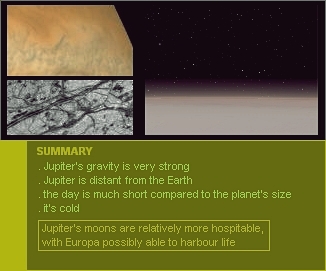
As you should weigh about 154 lbs (70 kg) on the Earth, you are weighing as much as 363 lbs (165 kg) on Jupiter! We are now at 484 million miles (779 million kilometers) from the Sun! We are there entering the domain of the faraway planets of the solar system. The sunlight, now, is taking as much as 43 minute to reach us (like a comparison, it takes 3 minute to reach Mercury, 6 to reach Venus, 8 to the Earth and 13 to Mars). The year at Jupiter is lasting 12 Earth years but the day, on the other hand, is swift, at 10 Earth hours only. This swift rotation is due to that all the four gas giants are rotating very quickly about themselves. Jupiter's axial tilt is weak only, leading to that there are no seasons at Jupiter. The eccentricity of the orbit, on the orbit, is relatively few important, adding nothing to
The mean surface temperature, at Jupiter, is cold, at -166° F (-110° C), due to the Sun becoming to be much distant. Jupiter features a magnetosphere which protects it from the solar radiations. Jupiter's magnetosphere is one of the largest in the solar system
As far as the concept of 'landscape' is concerned, it's about of no use for Jupiter as the external layer of the gas giant is just the ultimate layer of clouds and haze! According to the distance at which any orbital station would lie around Jupiter, the main features of the atmosphere of Jupiter, like the bands and zones of clouds, or the famed Great Red Spot, should appear more distinctly. The enormous diameter of Jupiter makes that one has a feeling of tremendously gigantic distances to the horizon, as that may be attenuated by the fact that Jupiter lack any ground nor relief. As seen from the Jupiter's system, any planet, down to Mars, are seen like morning -or evening- stars. The other planets, starting at Saturn, are seen moving along the zodiac
Jupiter, in total, is possessing 63 moons. All but the famed four 'Galilean moons' are mere boulders, about 3,300-foot (1-kilometer) wide. The four Galilean moons are those satellites of Jupiter which were discovered by Galileo Galilei, when he used one of the first astronomical refractors. Those are Io, Europa, Ganymede, and Callisto. Those four moons are orbiting in the equatorial plane of their mother-planet and that leads to they generating frequent eclipses on Jupiter, and being themselves frequently eclipsed by Jupiter itself. Jupiter also features a ring system as it's however so weak it is not visible from the planet nor the moons. The four main Galilean satellites, from any of them, are relatively visible
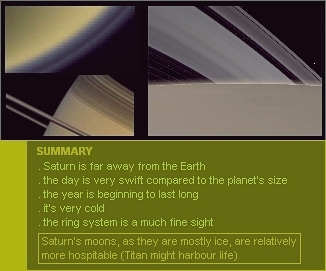
As you should weigh about 154 lbs (70 kg) on the Earth, you weigh about the same weight at Saturn, at 142 lbs (65 kg). We are now at 891 million miles (1.434 billion km) from the Sun. The sunlight now takes 1 hour and 19 minute to reach us! The Saturnian year is lasting 29.5 Earth years and the day, due to the swift rotation of Saturn, is lasting 11 Earth hours only. The axial tilt of Saturn being strong, in the order of that of the Earth, that generates a phenomenon of seasons along the year of Saturn
The mean surface temperature, at Saturn, is of -220° F (-140° C). Saturn is protected by a magnetosphere
The 'landscape' at Saturn, like for Jupiter, just consists into the sight of the last layer of gas and haze of the gas giant. Saturn however is ornated by its famed, magnificent system of rings. It's well visible from the planet as it provides, further, for the most remarkable views according to the latitude. The bands and zones -and even the spirals of the cyclons- in the atmosphere of Saturn are less visible than at Jupiter due to that Saturn features very strong winds. All the planets of the solar system now, up to Jupiter, are seen like morning -or evening- stars. Uranus, Neptune and Pluto only are seen moving against the starry background, along the zodiac. The immense diameter of Saturn, like at Jupiter, brings to a sensation of the farness of the horizon
Saturn, in total, possesses about thirty satellites, as 8 of those moons only are of importance. Those 8 moons are icy worlds, with Titan surpassing all its siblings in size and being of the largest moons in the solar system. Among those 8 major moons of Saturn, we have retained 5 only, which we are presenting below (it looks like another satellite, Enceladus, be too favourable to life. The Saturnian system, further, is currently under deep scrutiny from the Cassini mission)
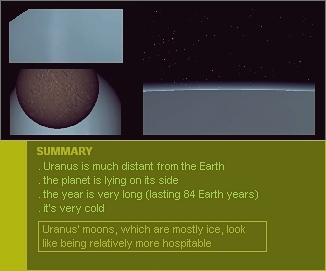
As you should weigh about 154 lbs (70 kg) on the Earth, you weigh about the same weight at Uranus, 137 lbs (62 kg). We are now at 1.784 billion miles (2.873 billion km) from the Sun. The sunlight now takes 2 hours and a half to reach us and the Sun now tend to be a mere point in the sky. It's remaining well visible and luminous however. The year, at Uranus, is lasting 84 Earth years! The day is lasting few, like at any gas giant, with a length of 17 Earth hours. The poles' axis of Uranus is strongly tilted, by 98°, making that the planet is literally lying on its side. As the tilt is over 90°, Uranus has thus a rotation about itself which is at the opposite of the usual rotation -like at Venus- with the Sun rising West and setting East. This pecular configuration makes too that it's the poles of Uranus which, every 40 years, are, or not, exposed to the heat of the Sun. Between those 'summers' of Uranus, it is the equatorial and mid-latitudes who receive the heat of the Sun
The mean surface temperature, on this faraway world, begins to be much cold, at Saturn, is of -320° F (-195° C). Uranus features a magnetosphere, the axis of which, in turn, est tilted by 58.6° compared to the strongly tilted poles' axis; this axis of the magnetosphere, further, is not centered to the center of Uranus but it is shifted by 30 percent compared to it
Like for Jupiter and Saturn, there is no landscape, to speak, on Uranus as the planet doesn't have either any surface and is limited by its last layer of gas only. Uranus is featuring a remarkable blue-green color. The horizon, on Uranus, seems nearer than at Jupiter or Saturn because Uranus is smaller than both. All the planets of the night sky, now, up to Saturn itself, are morning -or evening- stars only, with Neptune and Pluto only seen like moving along the zodiac and the starry sky. Uranus, like Jupiter, is featuring a ring system, as it is not visible from the planet neither
Uranus is featuring 27 moons, 5 of which only are of importance. Those 5 moons -Titania, Oberon, Umbriel, Ariel and Miranda- are still ill-known. They have not been visited back since the 1980s, when they were observed by the Voyager 2 mission. Those moons are icy, faraway worlds
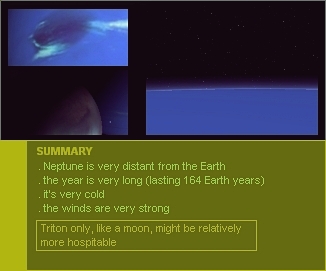
As you should weigh about 154 lbs (70 kg) on the Earth, you weigh about the same weight at Neptune, at 174 lbs (80 kg). We are now at 2.793 billion miles (4.495 billion km) from the Sun, a tremendous distance! The sunlight now takes more than 4 hours to reach us. Any radio communication with the Earth does take the same amount of time, one way! The Sun is a mere point in the sky, albeit remaining well seen and luminous. The year at Neptune is reaching the remarkable length of 164 Earth years, which means that a human, along its life, can not see a whole orbit of the planet! The day, like on any gas giant, is short, at 16 Earth hours. The axial tilt, at Neptune, has a value of 28.3°, which is near the one of the Earth. Thus, it's generating too a phenomenon of seasons. Each season however, on Neptune, is lasting about 40 years!
The mean surface temperature, at Neptune, is of -330° F (-200° C). Neptune possesses a magnetosphere, the axis of which is tilted by 50° compared to the planet's poles axis, as, like at Uranus, it is shifted by 25 percent from the planet's center
Like for the previous gas giants, the landscape at Neptune is its last layer of gas and haze only. The winds, in the atmosphere of Neptune, are the strongest in the solar system, at 1,240 mph (2,000 km per hour). The weather activity, in the last layer of the atmosphere of Neptune is stronger than at Uranus, as one can see there strong spots. Like for Uranus, the horizon is looking like nearer than at Jupiter or Saturn because the planet is relatively smaller than those both. Neptune, too, possesses a system of rings, which is weak and non-visible from the planet. All the planets of the solar system now, Pluto excepted, are morning -or evening- stars only
Like the three other gas giants, Neptune possesses an important number of moons, at 13. 4 of them only are of importance. Those are Triton -the largest of them- Proteus, Nereid, and Larissa. Those moons has been visited in the 1980s only, by the Voyager 2 mission as they are remaining relatively ill-known. They likely are icy world and the three ones which are smaller than Triton have an aspect of asteroids. The plane of the orbit of Triton is about inverted compared to Neptune's equatorial plane, with a value of 150°. This gives Triton a feeling that it's having a retrograde orbit, revolving about its mother-planet clockwise, which is the opposite of most of the solar system's moons
Pluto is not a gas giant anymore. Pluto, usually, is classified a 'telluric' planet, a planet which is similar to the Earth, made of rocks that is. The recent discovery and exploration of the 'Kuiper Belt', this other ring of asteroidal leftovers of the formation of the solar system, might tend to have Pluto now considered like a world belonging to such that zone
| Pluto |
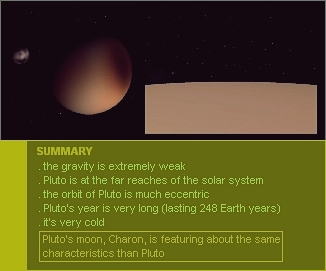
As you should weigh about 154 lbs (70 kg) on the Earth, you would weigh a mere 11 lbs (5 kg) only on Pluto. This is due to a remarkably weak gravity at the planet. We are, on average, at a distance of 3.647 billion miles (5.870 billion kilometers) from the Sun! The sunlight takes 5 hour and 20 minute before reaching us! The year of Pluto is lasting 249 Earth years, with the day lasting 6.3 Earth days. Pluto is rotating about itself clockwise -which is at the opposite of the usual, counterclockwise rotation of the other planets and moons in the solar system. This is because the axial tilt of Pluto is reaching 122°. Pluto is lying on its side, and beyond, with its pole under the orbit's plane by 30°. The orbit of Pluto is much eccentric, in the broader sense of the term. Pluto's orbit plane, first, is strongly tilted, by 17°, which is the largest value in the solar system compared to the ecliptic. At a moment of its orbit, Pluto is overlooking the whole solar system by 17° and, at another moment, it is under the mean plane of it by the same value. The eccentricity of Pluto's orbit -in the proper sense that time, the shape of the orbit compared to a circle, and which determines a point of the orbit the farthest Sun, and another one the closest- is too the largest in the solar system. The difference is 1.8 billion miles (3 billion km) between the perihelion, and the aphelion of the orbit! Pluto, thus, at its nearest Sun, is inside the orbit of Neptune! It is possible that such an orbit, which is very different from the other orbits in the solar system, be a hint to that Pluto better belongs to the world of the icy objects of the Kuiper Belt than to the one of the most usual, regular other planets of the solar system. The pecularities of the orbit of Pluto likely is bringing strong seasonal effects on the planet, both due to the eccentricity proprer, as the strong inclination of it, and the strong, inverted axial tilt of Pluto surely are adding too to such a phenomenon of seasons
The mean surface temperature, on the faraway world that Pluto is, is of -375° F (-225° C). One doesn't know whether the planet holds a magnetosphere
Pluto is still ill-known. Its surface likely is mostly frozen gas and ice. Pluto possesses a very thin atmosphere which, however, doesn't allow for an alternance between the night and day. Daylight is dim on Pluto due to a long distance away from the Sun. High noon light is equivalent to the light seen during dawn and dusk each day on Earth. Pluto never has been visited, until now, by any space mission as Pluto and its main moon, Charon, will be better known with the 'New Horizons' mission will flyby at the planet by 2015. As seen from Pluto, all the other planets of the solar system are now morning -or evening- stars
Pluto has one moon, which is named Charon. Some consider Charon like more of a twin planet to Pluto -due to the important size of Charon, which is one-fourth of that of Pluto- than like a real moon. The orbit of Charon is totally synchronous, which means that the satellite always have the same side turned to Pluto -like our Moon- as, further, the near side of Charon always points to the same point of the surface of Pluto, because Charon is orbiting about Pluto in the same amount of time than Pluto self if rotating about itself. Two diminutive moons -which are mere asteroids- have been recently discovered to Pluto
Website Manager: G. Guichard, site 'Amateur Astronomy,' http://stars5.6te.net. Page Editor: G. Guichard. last edited: 9/30/2011. contact us at ggwebsites@outlook.com